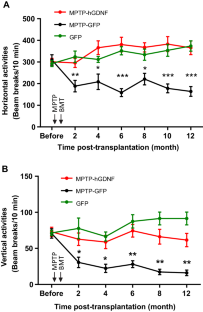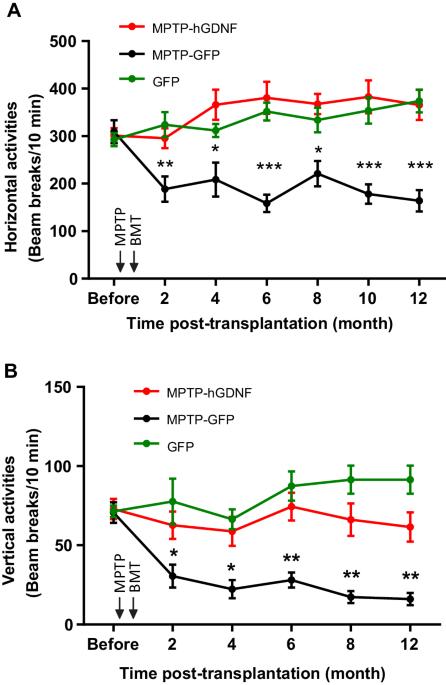基于造血干细胞的巨噬细胞/小胶质细胞向帕金森病小鼠模型的中枢神经系统输送 GDNF 的长期益处
IF 4.5
3区 医学
Q1 BIOCHEMISTRY & MOLECULAR BIOLOGY
引用次数: 0
摘要
胶质细胞系源性神经营养因子(GDNF)能保护各种帕金森病(PD)模型中的多巴胺能神经元。基于细胞的 GDNF 基因递送可减轻帕金森病小鼠的神经退行性变,并改善其运动和非运动功能。由于帕金森病是一种慢性疾病,本研究旨在调查基于造血干细胞(HSC)的巨噬细胞/小胶质细胞介导的中枢神经系统GDNF(MMC-GDNF)递送在MPTP(1-甲基-4-苯基-1,2,3,6-四氢吡啶)小鼠模型中的持久益处。结果表明,GDNF治疗能有效改善MPTP诱导的运动障碍,持续时间长达12个月,这与保护黑质多巴胺能神经元及其纹状体终端的作用相吻合。此外,造血干细胞衍生的巨噬细胞/小胶质细胞被选择性地招募到黑质的神经退行性区域。治疗益处似乎涉及两种机制:(1)巨噬细胞/小胶质细胞释放含GDNF的外泌体,并将其转移到靶神经元;(2)巨噬细胞/小胶质细胞直接释放GDNF,并扩散到靶神经元。此外,研究还发现血浆中的GDNF水平比基线水平显著增加,并随着时间的推移保持稳定,有可能成为未来临床试验的一种方便的生物标志物。值得注意的是,研究人员没有观察到体重减轻、食物摄入量改变、小脑病变或其他不良反应。总之,这项研究为基于造血干细胞的MMC-GDNF递送治疗帕金森病的长期疗效和安全性提供了令人信服的证据。本文章由计算机程序翻译,如有差异,请以英文原文为准。


Long-term benefits of hematopoietic stem cell-based macrophage/microglia delivery of GDNF to the CNS in a mouse model of Parkinson’s disease
Glial cell line-derived neurotrophic factor (GDNF) protects dopaminergic neurons in various models of Parkinson’s disease (PD). Cell-based GDNF gene delivery mitigates neurodegeneration and improves both motor and non-motor functions in PD mice. As PD is a chronic condition, this study aims to investigate the long-lasting benefits of hematopoietic stem cell (HSC)-based macrophage/microglia-mediated CNS GDNF (MMC-GDNF) delivery in an MPTP (1-methyl-4-phenyl-1,2,3,6-tetrahydropyridine) mouse model. The results indicate that GDNF treatment effectively ameliorated MPTP-induced motor deficits for up to 12 months, which coincided with the protection of nigral dopaminergic neurons and their striatal terminals. Also, the HSC-derived macrophages/microglia were recruited selectively to the neurodegenerative areas of the substantia nigra. The therapeutic benefits appear to involve two mechanisms: (1) macrophage/microglia release of GDNF-containing exosomes, which are transferred to target neurons, and (2) direct release of GDNF by macrophage/microglia, which diffuses to target neurons. Furthermore, the study found that plasma GDNF levels were significantly increased from baseline and remained stable over time, potentially serving as a convenient biomarker for future clinical trials. Notably, no weight loss, altered food intake, cerebellar pathology, or other adverse effects were observed. Overall, this study provides compelling evidence for the long-term therapeutic efficacy and safety of HSC-based MMC-GDNF delivery in the treatment of PD.
求助全文
通过发布文献求助,成功后即可免费获取论文全文。
去求助
来源期刊

Gene Therapy
医学-生化与分子生物学
CiteScore
9.70
自引率
2.00%
发文量
67
审稿时长
4-8 weeks
期刊介绍:
Gene Therapy covers both the research and clinical applications of novel therapeutic techniques based on a genetic component. Over the last few decades, significant advances in technologies ranging from identifying novel genetic targets that cause disease through to clinical studies, which show therapeutic benefit, have elevated this multidisciplinary field to the forefront of modern medicine.
 求助内容:
求助内容: 应助结果提醒方式:
应助结果提醒方式:


